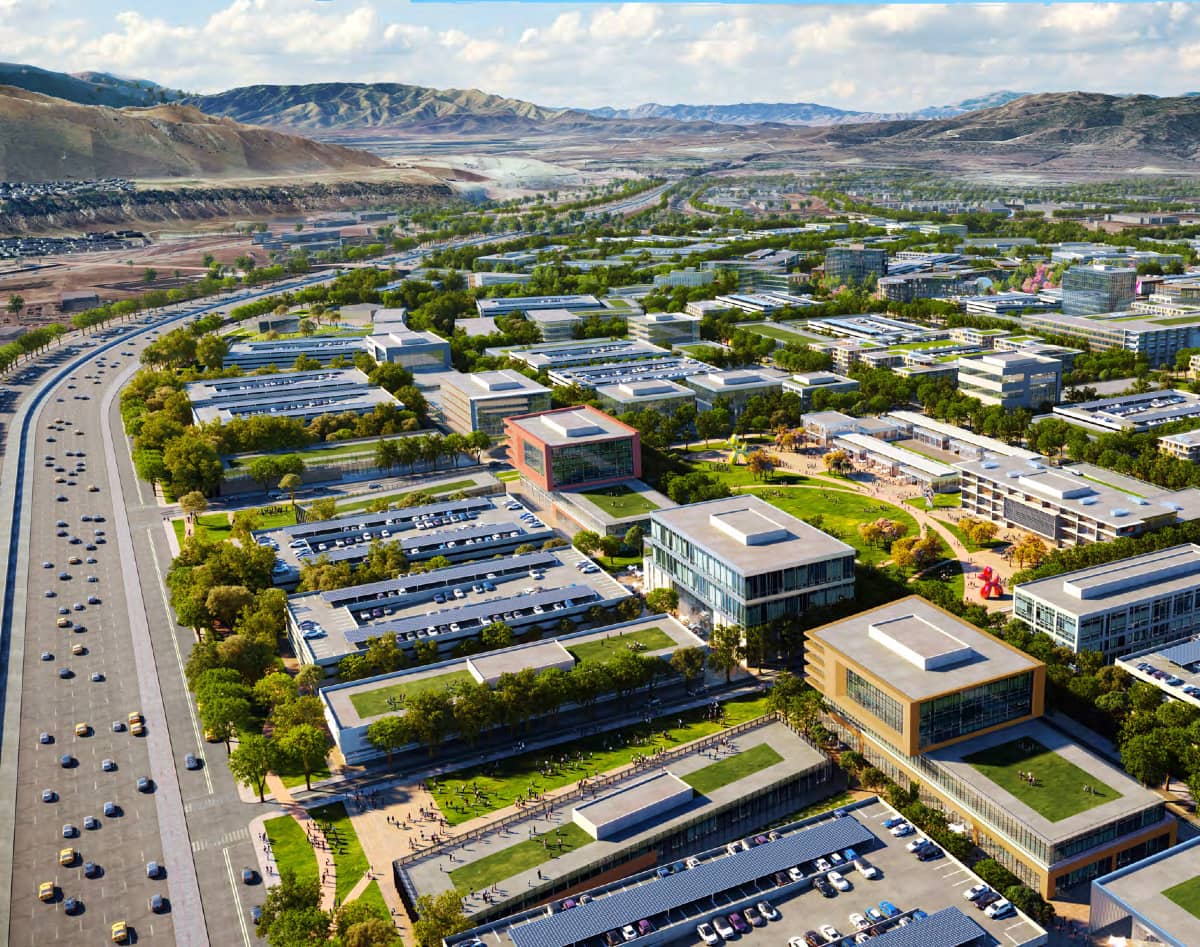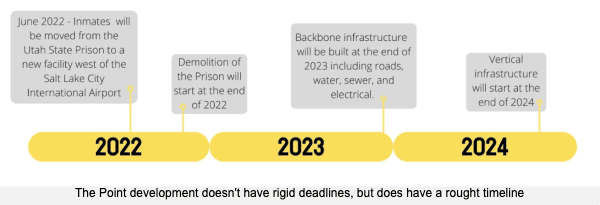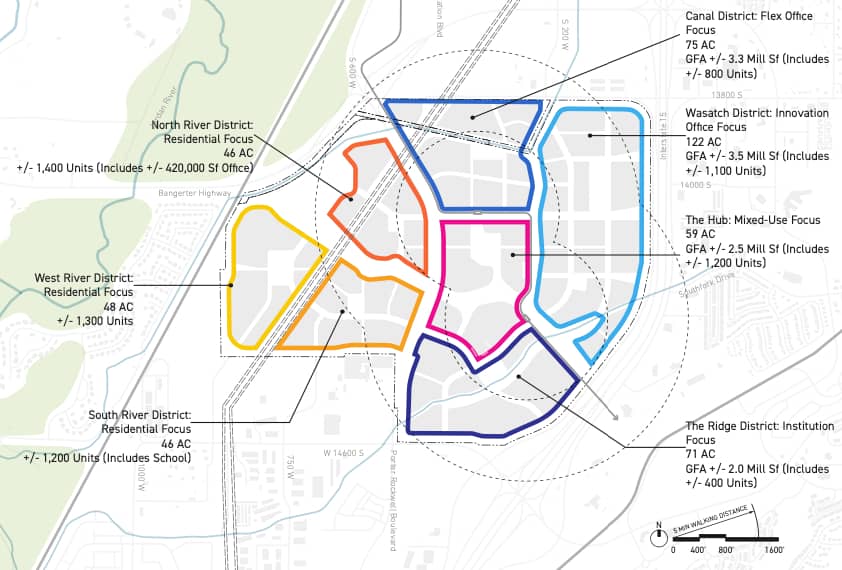

Utah's population has seen enormous growth over the past decades, with much of that happening at the point of the mountain. The area encompasses parts of Lehi, Bluffdale, and Draper, at the midpoint between Utah County and Salt Lake County. As tech companies compete for talent in both areas, the point has become the de facto hub for tech and job growth. That's driving efforts to make the area even more welcoming.
The Point of the Mountain State Land Authority (Land Authority) released plans for the highly anticipated land development project at the point of the mountain, known as The Point, in August 2021. The project has been in the works since 2014 and is seen as one of the most promising commercial and mixed-use development opportunities in the country.
TechBuzz briefly wrote about the development when the framework plan was first released. As curiosity has increased, TechBuzz sat down with Alan Matheson, the Executive Director of the Point of the Mountain State Land Authority (POMSLA), to learn more about the project, timeline, and goals for the coming transformation of the state-owned land currently occupied by the Draper State Prison.
 Construction on The Point will start after the removal of the Utah State Prison, clearing 600 underdeveloped acres in Draper, adjacent to Bluffdale, a place Utahns refer to as “The Point of the Mountain.” The Point will be an all-in-one, environmentally conscious community, centered on innovation.
Construction on The Point will start after the removal of the Utah State Prison, clearing 600 underdeveloped acres in Draper, adjacent to Bluffdale, a place Utahns refer to as “The Point of the Mountain.” The Point will be an all-in-one, environmentally conscious community, centered on innovation.
“The Point provides a remarkable once-in-a-generation opportunity,” says Matheson. “When people look at it, they'll see a modern, active community that's welcoming to all and very much focused on the future. ”
The Legislature created the Land Authority in 2018 and established an 11-person board to oversee the project. Members of the board include state legislators, agency executives, local elected officials, and business leaders. The board appointed Matheson a year later.
As the land is owned by the state, the board has taken action to involve the community by focusing on transparency. The board live-streams all public meetings, including monthly board meetings, and posts recordings to the Point website so the community can stay informed.
Over the past year, over 10,000 community members have shared their ideas and priorities for The Point through open houses, surveys, and stakeholder groups. The public priorities included job creation, workforce development, reducing energy and resource use, improving air quality, including open spaces, and exploring a nationally recognized research center. All of these objectives have been integrated into The Point development plans.
Matheson says coordinating traffic and transportation have been one of the main priorities for The Point.
“We’ve put a lot of thought into future-focused transportation strategies,” says Matheson. “We’ve explored strategies to minimize offsite traffic generation, transit alternatives that can get people to, from, and through the site, and internal autonomous electric circulators that will allow people to access any point in the site within a five-minute walk. There is also a real focus on pedestrian alternatives, bicycles, and other active transportation for commuting and recreation.”
The Point will be a “one-car community,” meaning each family should only need one car, as the community will be a mix of residential, offices, recreation, and shopping. Anyone on the site will be able to access all areas without a car.
The UTA is actively working on a plan to bring transit from the Draper Frontrunner station, through The Point, across I-15, and into Utah County. UDOT is also working on a plan to create one-way frontage roads along I-15 that will allow improved access to the site.
 The timeline is tentative, as the board has focused on “taking the long view.”
The timeline is tentative, as the board has focused on “taking the long view.”
“It's more important to get this right than to do it fast,” says Matheson. “To some extent, because this is state land, we can be a little more patient. We don't need to meet a quarterly revenue goal. We want to bring the benefits of the project to the public, but we can be a little patient and allow the market to catch up with our vision. We hope to look back on this as something that really made a positive difference in the community.”
The Point will have seven distinct districts. South River District, North River District, and West River District will be primarily residential areas. Wasatch District will house innovation office spaces, while the Canal District will have normal office buildings.
 Ridge District will have an institutional focus, which was a suggestion from the public. Ideally, this would be a place where the state universities can conduct early stage research and nurture ideas with the support of incubators, accelerators, and venture capital.
Ridge District will have an institutional focus, which was a suggestion from the public. Ideally, this would be a place where the state universities can conduct early stage research and nurture ideas with the support of incubators, accelerators, and venture capital.
The seventh district, The Hub, will be a mix of residential, commercial, and entertainment spaces.
23.5% of the area site is dedicated to open space. A national standard for municipalities states that all residents should be within a 10 minute walk of a park, but The Point will have parks within a 2 minute walk from every resident. These open spaces include 6 smaller parks, a central park (6.5 acres) and a River to Range Community parkway that will connect the Jordan River parkway to the foothill trails east of I-15.
Because there is no community quite like The Point, the board took inspiration from communities all over the world. They looked at King’s Cross, an area in central London that was once a hub of industrial activity, but degenerated after World War II. Beginning in the early 2000s, the site was rejuvenated with new construction and an increased focus on cultural activity, with fine dining, museums, and commercial centers. Nearby St. Pancras Station also serves as the terminus to the Eurostar rail system, with regular trains to and from Paris and Belgium. The board also looked at Canary Wharf, another London neighborhood just off the River Thames that was similarly urbanized in the 90s and early 2000s after an industrial history. Closer to home, the team looked at Lake Nona in Florida, a planned community that grew from just 1,500 in 2000 to over 50,000 people by 2015. The Philadelphia Navy Yard was also studied as an area that was urbanized after the US Navy ended all operations there in the 90s. The group also considered innovative ideas from Mission Bay in San Francisco, which also underwent a total renewal after the shipbuilding and repair industries declined by the mid nineties.
The Point will be different from other new suburban developments like Daybreak or Vineyard as it will have a more central business district with more compact development.
“We want The Point to demonstrate Utahns’ care for their surroundings, and for those who will be living here in 50 years,” says Matheson. “If we do this right, we can create this innovation community that has a culture of creativity, where all the elements bring thoughtful, smart people together and give them the tools to innovate and solve problems. We hope that this is a catalyst for our grandchildren to have world-class careers here in Utah and not have to go elsewhere.”

